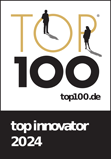Bluhm Systeme printers at the heart of logistics at the Süddeutsche Zeitung’s printing facility
Smart, Fast and Reliable
When the Süddeutsche Zeitung transitioned to offset-print production in the 1980s, the company erected a modern printing facility in Munich-Bogenhausen – with an industrial printing building towering over it at 18 metres. Today, 320 employees of Süddeutsche Verlag Zeitungsdruck GmbH work around the clock to make 3 million print products a day. After pre-press stage and production, the individual products go through post-press processing and are then dispatched through 20 different loading bays. Because of the intricate logistics the industrial marking and labelling solutions involved need to be smart, long-lasting, fast and reliable. That is why Süddeutscher Verlag uses Bluhm Systeme Integra Quadro printers.
Challenge
- individual top sheets to provide an exact identification of the newspaper packages
- encryption of printing information in the form of a barcode
- full exploitation of the standard DIN A4-page
- cost-effective to buy and run
- connection to control system of the FERAG-system
- no cleaning effort of the printing heads even with 3-18 hours of idle time
Result
- layout of the top sheets ini-Design software
- printing information is printed on in plain text and encoded as a barcode
- fast and cost-effective Markoprint Piezo-Inkjetdrucker
- data transmission via ethernet und USB to the Integra Quadro controller
- long life of the printing heads
The Crucial Role of Logistics
The newspaper bundles need to be clearly identified along the entire logistics chain. That is why they are equipped with individual top sheets. These DIN A4–sized sheets are printed with specific information, including sender and recipient, details about the bundle’s contents (such as edition and number of copies). The same information is also encoded in a barcode to enable automated transport of the bundles. “We print the code onto three different parts of the top sheet. That way it can be reliably scanned even when the bundles are shrink-wrapped and cross-strapped,” says Günter Schaller.
“We desperately needed to modernise how we printed the top sheets,” says Werner Antretter, Head of Maintenance. For cost reasons, the company wanted to continue to focus on piezo-inkjet systems.In addition to the cost of printing, other aspects were also important for the modernisation project. Werner Antretter wanted the printing system to seamlessly interface with the FERAG machinery. He also expected the new system’s printing quality to be good enough to achieve a higher reading rate or, in other words, a lower no-read rate. On top of that, idle times of 3 to 18 hours should not lead to a need to clean the printheads.
As a result of these deliberations, Süddeutsche Verlag Zeitungsdruck chose Bluhm Systeme’s Markoprint piezo-inkjet printers. Geißler Kennzeichnungstechnik from Norderstedt by Hamburg, a Bluhm distribution partner, planned, implemented and installed the systems. Today, the printing facility uses 20 Integra Quadro controllers with a total of 40 printheads.
Seamless Software Compatibility
“The printing systems easily tied into existing software,” Werner Antretter happily reports. Data, such as newspaper supplement and packing information, are transmitted to the Integra Quadro printing-system controllers via Ethernet or USB. Das Design der Deckblätter erfolgt mit der Software i-Design der Markoprint-Drucksysteme. Top sheets are designed and generated with the Markoprint software iDesign, where individual top-sheet layouts are stored. Remote fields are automatically filled in during the transmission of the print data. The printheads write the information onto the top sheet – both in plain text and as a barcode. Data are transferred to the printheads 1:1, allowing for real-time printing without batch processing. The printing systems reach the impressive speed of up to 240 m per minute at 300 dpi. “In addition to excellent printing quality, we also have a need for speed,” explains Werner Antretter. “In theory, 30,000 bundles per day mean that we would need to print more than a page per second throughout every 8-hour shift.” The printheads use Trident piezo technology, which enables them to print at a 100 mm distance. Since two heads are mounted with a slight offset and work together, they can print barcodes that are larger than an inch. Three identical barcodes are printed onto different parts of the top sheet to prevent reading errors that would slow down overall logistics.
Ideally Suited Piezo Technology
Drop-on-demand printers expel ink drops from the cartridges to meet the exact demand. This requires pressure pulses that can be generated in two different ways in an industrial setting. While the thermal-inkjet method utilises heat, the piezo-inkjet one uses voltage. When voltage is applied to piezoelectrical material (crystal or ceramics), the material changes shape. The distortion creates a pressure pulse in the ink chamber of the cartridge. As a result, ink drops flow out of the printer nozzles. Reversing the voltage makes the material contract, sucking new ink into the chamber.
It is faster to apply voltage than it is to warm up heating elements. That is why piezo-inkjet printers can reach lightning-fast printing speeds. The systems use an oil-based ink. Not only is it highly efficiently supplied in high volumes, it can be replaced during ongoing operations – without interrupting printing. The printheads also boast a long life. Günter Schaller couldn’t be more pleased. “We have strict criteria for every system we use at our printing facility. Markoprint Integra Quadro printers meet all of them!”






